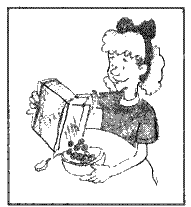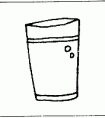看图填空。1. combing her 2.her face3.his teeth4.eating her b -六年级英语
题文
| 看图填空。 |
1. combing her |
2. her face |
3. his teeth |
4. eating her b |
答案
| 1. hair 2. washing 3. brushing 4. breakfast |
据专家权威分析,试题“看图填空。1. combing her 2.her face3.his teeth4.eating h..”主要考查你对 不可数名词,动名词 等考点的理解。关于这些考点的“档案”如下:
不可数名词动名词
考点名称:不可数名词
- 不可数名词:
是指不能以数目来计算,不可以分成个体的概念、状态、品质、感情或表示物质材料的东西;
它一般没有复数形式,只有单数形式,它的前面不能用不定冠词a / an ,若要表示它的个体意义时,必须与一个名词短语连用,相当于中文里的【一 +(量词)+ 名词】,其中的量词意义依与具体的名词搭配而定。不可数名词 uncountable none 常用缩写为un。 可数名词与不可数名词区别:
可数名词是指能以数目来计算,可以分成个体的人或东西;
因此它有复数形式,当它的复数形式在句子中作主语时,句子的谓语也应用复数形式。
例如:Little children are fond of stories .小孩子们喜欢听故事。
Movie stars are usually popular with young people. 影星们常受到年青人的欢迎。
它的单数形式前常用不定冠词a / an , 当它的单数形式在句子中作主语时,句子的谓语也应用单数形式。
例如:There is an orange on the table .桌上有只桔子。
A university is a higher educational institution .大学是高等教育机构。
不可数名词是指不能以数目来计算,不可以分成个体的概念、状态、品质、感情或表示物质材料的东西;
它一般没有复数形式,只有单数形式,它的前面不能用不定冠词a / an ,若要表示它的个体意义时,必须与一个名词短语连用,相当于中文里的【一 +(量词)+ 名词】,其中的量词意义依与具体的名词搭配而定。
例如: a piece of bread【 cake(蛋糕), paper(纸), thread(线), cloth(布),furniture(家具), coal(煤), news(新闻), advice(意见), information(信息), work(工作), meat(肉) 】
一块面包【 一块蛋糕、一张纸、一根线、…… 】
an item of information 一则情报
a burst of applause 一阵掌声
a fit of anger 一顿脾气
a slip of paper 一张纸条
a length of cloth 一段布料
a cake of soap 一块肥皂
a tube of tooth-paste 一条牙膏
a bottle of ink 一瓶墨水
它在句子中作主语时,句子的谓语也只用单数形式。
例如: Water is a liquid .水是液体。
Wealth doesn't mean happiness .富有并不意味幸福。- 小学常见不可数名词:
物质名词和抽象名词大多为不可数名词,没有复数形式,前面一般也不能由不定冠词限定。
1、小学常见的物质名词有
表示液体的water, juice, milk, lemonade, coffee, coke, ink, tea, honey, jam等,
表示食物的food, rice, tofu, eggplant, bread, butter, cheese, chocolate, sugar等,
表示肉类的meat, mutton, beef, chicken, fish等,
表示其他无固定形状的物质的paper, dust, sand, gold, grass, chalk, glass, cloth, coal等。.
2、小学常见的抽象名词有:
news, weather, traffic, fun, work, money, luck, medicine, music, homework, housework,等.
考点名称:动名词
- 动名词:
如果一个动词加上了-ing变成了名词,那么这个词称动名词。 动名词是一种兼有动词和名词特征
的非限定动词。它可以支配宾语,也能被副词修饰。动名词有时态和语态的变化。
例:Reading is an art. 读书是一种艺术。
Swimming is a good sport in summer. 游泳是夏天一项好的运动。
There is no saying when he'll come. 很难说他何时回来。
No smoking. (=No smoking is allowed here) . 禁止吸烟!
No parking. 禁止停车!
Let’s go shopping. 让我们去购物。 动名词常见题型:
1)动名词做主语时,谓语动词为单数
2)在动名词和不定式中,作为介词的宾语是动名词
3)动名词的否定直接在其前加否定词,通过代词的宾格或所有格形式给出逻辑主语
例:
I would appreciate_______ back this afternoon.
A.you to call
B.you call
C.you calling
D.you’re calling
(Key:C;换成your calling也对)
4)有些词后只能接动名词
acknowledge;admit; advise;advocate;allow;appreciate; avoid; celebrate; consider; contemplate; defer; delay; deny; detest; discontinue; dislike; dispute; enjoy; it entails; escape; excuse; explain; fancy; feel like; finish; forgive; can’t help; hinder; imagine; it involves; keep; it means; mention; mind; miss; it necessitates; pardon; postpone; practice; prevent; recall; report; resent; resist; risk; suggest; understand...
5)另外还有一些接-ing形式的常用说法
it’s no good; it’s no/little/hardly any/ use; it’s not/hardly/scarcely use; it’s worthwhile; spend money/time; there’s no; there’s no point in; there’s nothing worse than; what’s the use/point...
6)有些词后面加不定式和动名词均可
remember,forget,try,stop,go on,continue,stop,regret,cease,mean后面均可用不定式和-ing形式,但意义截然不容。
例:
remember to do/doing:
①I remembered to post the letters.(指未来/过去未来将要做的动作)
②I remembered posting/having posted the letters.(我记得做过这个动作)
forget与remember的用法类似。
regret的用法:
①I regret to inform you that…(我很遗憾地通知你……)
- 最新内容
- 相关内容
- 网友推荐
- 图文推荐
| [家长教育] 孩子为什么会和父母感情疏离? (2019-07-14) |
| [教师分享] 给远方姐姐的一封信 (2018-11-07) |
| [教师分享] 伸缩门 (2018-11-07) |
| [教师分享] 回家乡 (2018-11-07) |
| [教师分享] 是风味也是人间 (2018-11-07) |
| [教师分享] 一句格言的启示 (2018-11-07) |
| [教师分享] 无规矩不成方圆 (2018-11-07) |
| [教师分享] 第十届全国教育名家论坛有感(二) (2018-11-07) |
| [教师分享] 贪玩的小狗 (2018-11-07) |
| [教师分享] 未命名文章 (2018-11-07) |

![Wouldyoulikesome __________?[ ]A.fishsB.meatC.orangeD.pops-五年级英语](http://www.00-edu.com/d/file/ks/4/1/10/2019-08-10/small4c75c0a683b24324cb211e1f689283f61565374205.png)

![— Can I have _____________ envelope and some _____________?— Sure, here you are.[ ]A. an; writing paperB. a; writing papersC. a; writing paper-六年级英语](http://www.00-edu.com/d/file/ks/4/1/10/2019-08-10/small607be2a4279919a9e31d4e82a28a68831565374156.png)

![I'd like _____________. What about you? [ ]A. a bottle of orangesB. a bottles of orangeC. a bottle of orangeD. bottles of oranges-五年级英语](http://www.00-edu.com/d/file/ks/4/1/10/2019-08-10/smallb921618a5ccef017ecdea1bf565822071565374253.png)
